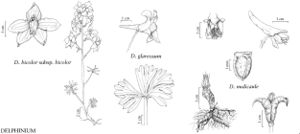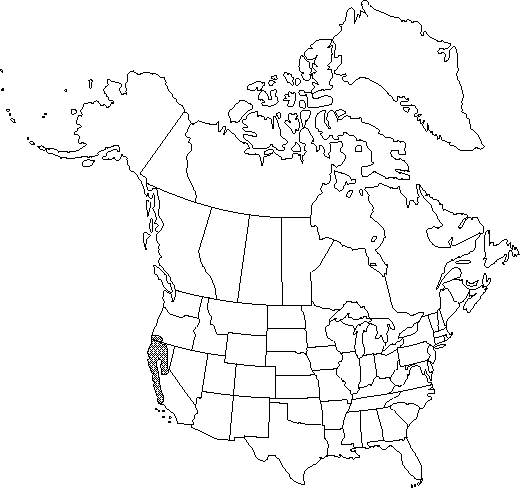Difference between revisions of "Delphinium nudicaule"
Fl. N. Amer. 1: 33. 1838.
FNA>Volume Importer |
imported>Volume Importer |
||
| (7 intermediate revisions by 2 users not shown) | |||
| Line 13: | Line 13: | ||
}}{{Treatment/ID/Special_status | }}{{Treatment/ID/Special_status | ||
|code=F | |code=F | ||
| − | |label= | + | |label=Illustrated |
}} | }} | ||
| − | |basionyms={{Treatment/ID/ | + | |basionyms={{Treatment/ID/Basionym |
|name=Delphinium armeniacum | |name=Delphinium armeniacum | ||
|authority=A. Heller | |authority=A. Heller | ||
| + | |rank=species | ||
| + | |publication_title= | ||
| + | |publication_place=1940 | ||
}} | }} | ||
|synonyms= | |synonyms= | ||
| Line 27: | Line 30: | ||
}}<!-- | }}<!-- | ||
| − | --><span class="statement" id="st- | + | --><span class="statement" id="st-undefined" data-properties=""><b>Stems </b>(15-)20-50(-125) cm; base reddish, glabrous. <b>Leaves</b> mostly on proximal 1/3 of stem; basal leaves 2-7 at anthesis; cauline leaves 3-4 at anthesis; petiole 0.5-14 cm. <b>Leaf</b> blade round to pentagonal, 2-6 × 3-10 cm; ultimate lobes 3-12, width 5-40 mm (basal), 2-20 mm (cauline). <b>Inflorescences</b> 5-20(-69)-flowered; pedicel (1.5-)2-6(-8) cm, glabrous to glandular-pubescent; bracteoles 14-20(-30) mm from flowers, green to red, linear, 2-4(-9) mm, glabrous to puberulent. <b>Flowers</b>: sepals scarlet to reddish orange, rarely dull yellow, glabrous, lateral sepals forward-pointing to form pseudotube, (6-)8-13(-16) × 3-6 mm, spurs straight, slightly ascending, (12-)18-27(-34) mm; lower petal blades elevated, exposing stamens, 2-3 mm, clefts 0.5-1 mm; hairs sparse, evenly dispersed, yellow. <b>Fruits</b> 13-26 mm, 3.5-4.5 times longer than wide, glabrous. <b>Seeds</b> unwinged or sometimes slightly wing-margined; seed coat cells with surfaces smooth. <b>2n</b> = 16.</span><!-- |
-->{{Treatment/Body | -->{{Treatment/Body | ||
| Line 34: | Line 37: | ||
|elevation=0-2600 m | |elevation=0-2600 m | ||
|distribution=Calif.;Oreg. | |distribution=Calif.;Oreg. | ||
| − | |discussion=<p>Delphinium nudicaule hybridizes with most other taxa of Delphinium that it encounters. Apparent hybrids involving D. nudicaule, and seen by the author (either afield or as specimens), include D. andersonii, D. antoninum, D. decorum, D. luteum, D. nuttallianum, D. patens, and D. trolliifolium. In addition, garden-grown plants have been hybridized with D. cardinale, D. elatum, D. menziesii, D. parishii, D. penardii, D. tatsienense Franchet, D. triste Fischer ex de Candolle, and D. uliginosum; D. nudicaule does not naturally occur with these species. Delphinium nudicaule is one of the earliest larkspurs to flower in any given locality. Douglas's type collection of D. nudicaule represents plants (synonyms D. sarcophyllum Hooker & Arnott and D. peltatum Hooker, an invalid name) grown under very moist conditions, probably quite near the ocean. The type specimen of D. armeniacum A. Heller represents plants grown under unusually dry conditions.</p><!-- | + | |discussion=<p><i>Delphinium nudicaule</i> hybridizes with most other taxa of <i>Delphinium</i> that it encounters. Apparent hybrids involving <i>D. nudicaule</i>, and seen by the author (either afield or as specimens), include <i>D. andersonii</i>, <i>D. antoninum</i>, <i>D. decorum</i>, <i>D. luteum</i>, <i>D. nuttallianum</i>, <i>D. patens</i>, and <i>D. trolliifolium</i>. In addition, garden-grown plants have been hybridized with <i>D. cardinale</i>, <i>D. elatum</i>, <i>D. menziesii</i>, <i>D. parishii</i>, D. penardii, D. tatsienense Franchet, D. triste Fischer ex de Candolle, and <i>D. uliginosum</i>; <i>D. nudicaule</i> does not naturally occur with these species. <i>Delphinium nudicaule</i> is one of the earliest larkspurs to flower in any given locality. Douglas's type collection of <i>D. nudicaule</i> represents plants (synonyms D. sarcophyllum Hooker & Arnott and D. peltatum Hooker, an invalid name) grown under very moist conditions, probably quite near the ocean. The type specimen of D. armeniacum A. Heller represents plants grown under unusually dry conditions.</p><!-- |
| − | --><p>The Mendocino Indians consider Delphinium nudicaule a narcotic (D. E. Moerman 1986).</p> | + | --><p>The Mendocino Indians consider <i>Delphinium nudicaule</i> a narcotic (D. E. Moerman 1986).</p> |
|tables= | |tables= | ||
|references= | |references= | ||
| Line 44: | Line 47: | ||
-->{{#Taxon: | -->{{#Taxon: | ||
name=Delphinium nudicaule | name=Delphinium nudicaule | ||
| − | |||
|authority=Torrey & A. Gray | |authority=Torrey & A. Gray | ||
|rank=species | |rank=species | ||
| Line 58: | Line 60: | ||
|publication title=Fl. N. Amer. | |publication title=Fl. N. Amer. | ||
|publication year=1838 | |publication year=1838 | ||
| − | |special status=Endemic; | + | |special status=Endemic;Illustrated |
| − | |source xml=https:// | + | |source xml=https://bitbucket.org/aafc-mbb/fna-data-curation/src/2e0870ddd59836b60bcf96646a41e87ea5a5943a/coarse_grained_fna_xml/V3/V3_414.xml |
|genus=Delphinium | |genus=Delphinium | ||
|section=Delphinium sect. Diedropetala | |section=Delphinium sect. Diedropetala | ||
|subsection=Delphinium subsect. Bicoloria | |subsection=Delphinium subsect. Bicoloria | ||
|species=Delphinium nudicaule | |species=Delphinium nudicaule | ||
| − | |||
| − | |||
| − | |||
| − | |||
| − | |||
| − | |||
| − | |||
| − | |||
| − | |||
| − | |||
| − | |||
| − | |||
| − | |||
| − | |||
| − | |||
| − | |||
| − | |||
| − | |||
| − | |||
| − | |||
| − | |||
| − | |||
| − | |||
| − | |||
| − | |||
| − | |||
| − | |||
| − | |||
| − | |||
| − | |||
| − | |||
| − | |||
| − | |||
| − | |||
| − | |||
| − | |||
| − | |||
| − | |||
| − | |||
| − | |||
| − | |||
| − | |||
| − | |||
| − | |||
| − | |||
| − | |||
| − | |||
| − | |||
| − | |||
}}<!-- | }}<!-- | ||
-->[[Category:Treatment]][[Category:Delphinium subsect. Bicoloria]] | -->[[Category:Treatment]][[Category:Delphinium subsect. Bicoloria]] | ||
Latest revision as of 21:48, 5 November 2020
Stems (15-)20-50(-125) cm; base reddish, glabrous. Leaves mostly on proximal 1/3 of stem; basal leaves 2-7 at anthesis; cauline leaves 3-4 at anthesis; petiole 0.5-14 cm. Leaf blade round to pentagonal, 2-6 × 3-10 cm; ultimate lobes 3-12, width 5-40 mm (basal), 2-20 mm (cauline). Inflorescences 5-20(-69)-flowered; pedicel (1.5-)2-6(-8) cm, glabrous to glandular-pubescent; bracteoles 14-20(-30) mm from flowers, green to red, linear, 2-4(-9) mm, glabrous to puberulent. Flowers: sepals scarlet to reddish orange, rarely dull yellow, glabrous, lateral sepals forward-pointing to form pseudotube, (6-)8-13(-16) × 3-6 mm, spurs straight, slightly ascending, (12-)18-27(-34) mm; lower petal blades elevated, exposing stamens, 2-3 mm, clefts 0.5-1 mm; hairs sparse, evenly dispersed, yellow. Fruits 13-26 mm, 3.5-4.5 times longer than wide, glabrous. Seeds unwinged or sometimes slightly wing-margined; seed coat cells with surfaces smooth. 2n = 16.
Phenology: Flowering late winter–early summer.
Habitat: Moist talus, cliff faces
Elevation: 0-2600 m
Discussion
Delphinium nudicaule hybridizes with most other taxa of Delphinium that it encounters. Apparent hybrids involving D. nudicaule, and seen by the author (either afield or as specimens), include D. andersonii, D. antoninum, D. decorum, D. luteum, D. nuttallianum, D. patens, and D. trolliifolium. In addition, garden-grown plants have been hybridized with D. cardinale, D. elatum, D. menziesii, D. parishii, D. penardii, D. tatsienense Franchet, D. triste Fischer ex de Candolle, and D. uliginosum; D. nudicaule does not naturally occur with these species. Delphinium nudicaule is one of the earliest larkspurs to flower in any given locality. Douglas's type collection of D. nudicaule represents plants (synonyms D. sarcophyllum Hooker & Arnott and D. peltatum Hooker, an invalid name) grown under very moist conditions, probably quite near the ocean. The type specimen of D. armeniacum A. Heller represents plants grown under unusually dry conditions.
The Mendocino Indians consider Delphinium nudicaule a narcotic (D. E. Moerman 1986).
Selected References
None.

